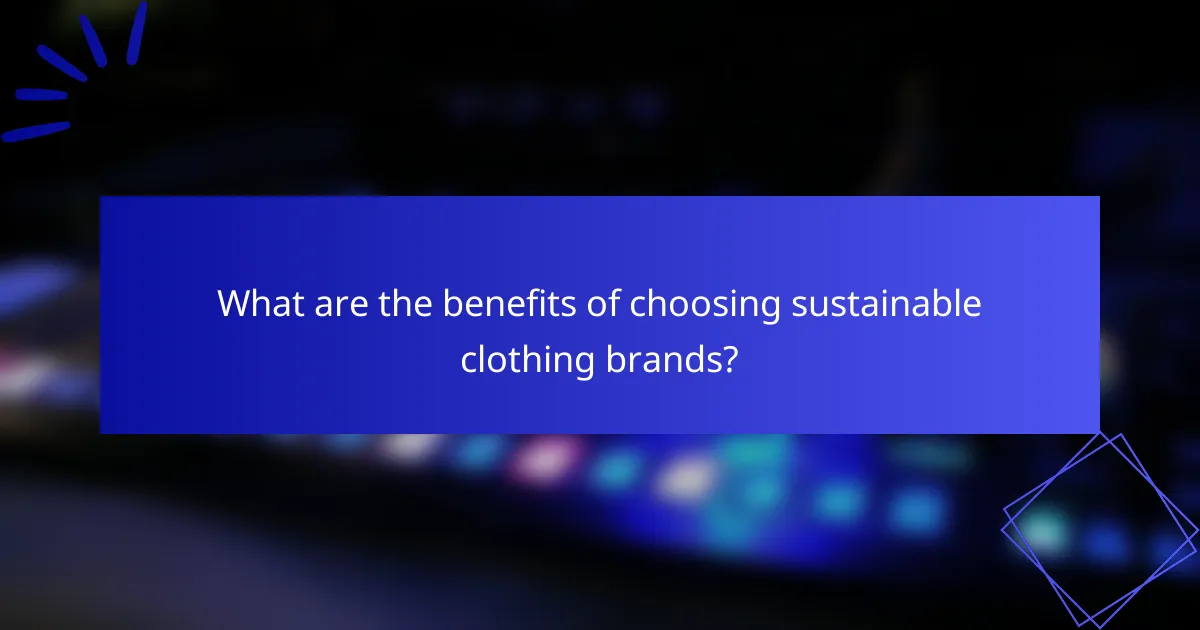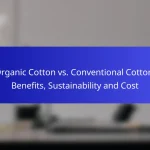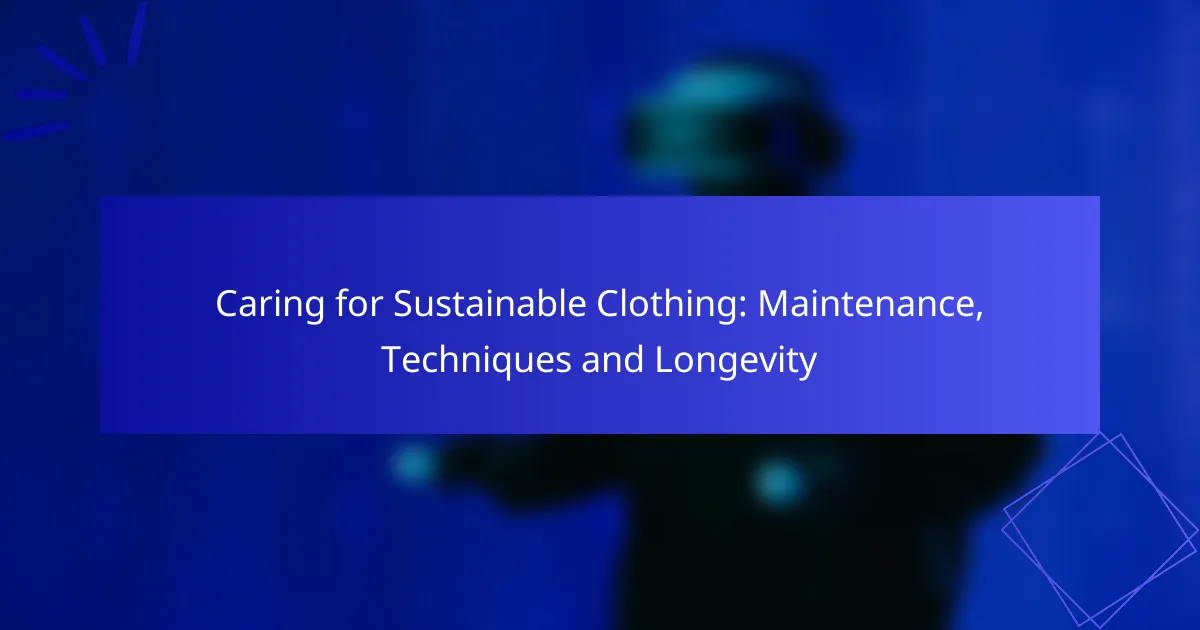Sustainable clothing is evaluated based on criteria such as environmental impact, social responsibility, and ethical labor practices, enabling consumers to make informed choices. Certifications like GOTS, OEKO-TEX, and Fair Trade serve as indicators of a brand’s commitment to sustainability. Additionally, materials such as organic cotton, Tencel, and recycled polyester play a crucial role in minimizing environmental impact and promoting ethical practices throughout their lifecycle.

What are the evaluation criteria for sustainable clothing?
The evaluation criteria for sustainable clothing focus on environmental impact, social responsibility, durability, transparency, and ethical labor practices. These factors help consumers make informed choices about their clothing purchases and support brands that align with their values.
Environmental impact
Environmental impact assesses how clothing production affects ecosystems, including resource use, pollution, and waste. Key considerations include the materials used, water consumption, and carbon emissions during manufacturing and transportation.
Brands that prioritize sustainability often use organic or recycled materials, which can significantly reduce their environmental footprint. Look for certifications like Global Organic Textile Standard (GOTS) or OEKO-TEX, which indicate lower environmental harm.
Social responsibility
Social responsibility evaluates how clothing brands contribute to the well-being of communities and societies. This includes fair wages, safe working conditions, and support for local economies.
Brands that engage in social responsibility often invest in community projects or provide education and training for workers. Researching a brand’s initiatives can reveal its commitment to positive social impact.
Durability and quality
Durability and quality refer to the lifespan and resilience of clothing items. Sustainable clothing should withstand regular wear and washing, reducing the need for frequent replacements.
When assessing durability, consider the fabric type and construction methods. Higher-quality materials like organic cotton or Tencel tend to last longer. Look for warranties or guarantees, which can indicate a brand’s confidence in its products.
Transparency in sourcing
Transparency in sourcing involves how openly a brand shares information about its supply chain. This includes details about where materials are sourced and how products are made.
Brands committed to transparency often provide information on their websites about sourcing practices and supply chain partners. Look for clear labeling and traceability, which can help ensure that products are ethically sourced.
Ethical labor practices
Ethical labor practices focus on the treatment of workers throughout the supply chain. This includes fair wages, reasonable working hours, and the prohibition of child labor and discrimination.
Brands that adhere to ethical labor practices often undergo third-party audits and certifications, such as Fair Trade or SA8000. Checking for these certifications can help consumers support brands that prioritize worker rights and welfare.

What certifications should I look for in sustainable clothing?
When seeking sustainable clothing, look for certifications that indicate environmental responsibility and ethical practices. Key certifications include GOTS, OEKO-TEX, Fair Trade, and Cradle to Cradle, each focusing on different aspects of sustainability.
Global Organic Textile Standard (GOTS)
The Global Organic Textile Standard (GOTS) is a leading textile processing standard for organic fibers. It ensures that textiles are made from at least 70% organic fibers and meet stringent environmental and social criteria throughout the supply chain.
When evaluating GOTS-certified clothing, consider the entire production process, including the use of non-toxic dyes and the prohibition of harmful chemicals. This certification also mandates fair labor practices, ensuring workers are treated ethically.
OEKO-TEX Standard 100
OEKO-TEX Standard 100 is a certification that focuses on the safety of textiles for human health. It tests for harmful substances in fabrics, ensuring that they are free from harmful chemicals that could pose risks to consumers.
Look for OEKO-TEX labels on clothing, especially for items that come into direct contact with the skin, such as underwear and baby clothes. This certification provides peace of mind regarding the safety of the materials used.
Fair Trade Certified
Fair Trade Certified clothing guarantees that producers receive fair wages and work in safe conditions. This certification emphasizes ethical labor practices and environmental sustainability, supporting communities in developing countries.
When choosing Fair Trade Certified apparel, consider the impact of your purchase on global trade practices. This certification often includes additional benefits for workers, such as community development funds and access to education.
Cradle to Cradle Certified
Cradle to Cradle Certified focuses on the lifecycle of products, promoting a circular economy. This certification evaluates materials for their safety, recyclability, and the overall environmental impact throughout their lifecycle.
When selecting Cradle to Cradle Certified clothing, look for brands that prioritize sustainable materials and design for recyclability. This certification encourages innovation in product design, aiming for a zero-waste approach in the fashion industry.

What materials are considered sustainable for clothing?
Sustainable clothing materials are those that minimize environmental impact and promote ethical practices throughout their lifecycle. Common examples include organic cotton, Tencel, recycled polyester, and hemp, each offering unique benefits and considerations.
Organic cotton
Organic cotton is grown without synthetic pesticides or fertilizers, making it a more environmentally friendly option compared to conventional cotton. It uses natural farming methods that enhance soil health and biodiversity.
When choosing organic cotton, look for certifications like GOTS (Global Organic Textile Standard) to ensure compliance with organic farming practices. This material typically has a softer feel and is less likely to irritate sensitive skin.
Tencel (Lyocell)
Tencel, also known as Lyocell, is made from sustainably sourced wood pulp, primarily from eucalyptus trees. The production process uses a closed-loop system that recycles water and solvents, significantly reducing waste and pollution.
This fabric is breathable, moisture-wicking, and biodegradable, making it a great choice for eco-conscious consumers. Look for Tencel products that carry certifications such as OEKO-TEX to ensure they are free from harmful substances.
Recycled polyester
Recycled polyester is created from post-consumer plastic waste, such as bottles, reducing the need for virgin polyester and lowering carbon emissions. This material helps divert plastic from landfills and oceans, contributing to a circular economy.
When selecting recycled polyester, check for certifications like Global Recycled Standard (GRS) to confirm the percentage of recycled content. It is durable and often used in activewear, but be mindful that it can still shed microplastics during washing.
Hemp
Hemp is a fast-growing plant that requires minimal water and no pesticides, making it one of the most sustainable fibers available. It enriches the soil and can be grown in diverse climates, promoting agricultural diversity.
Hemp fabric is strong, breathable, and naturally resistant to mold and UV light. When purchasing hemp clothing, look for brands that emphasize sustainable practices and transparency in their supply chains to ensure ethical sourcing.

How does sustainable clothing impact the environment in urban areas?
Sustainable clothing significantly reduces environmental harm in urban areas by minimizing waste and lowering carbon emissions. By prioritizing eco-friendly materials and practices, cities can mitigate pollution and resource depletion associated with the fashion industry.
Reduction of waste
Sustainable clothing practices focus on reducing waste through various strategies, such as using recycled materials and promoting circular fashion. This approach encourages consumers to buy less and choose higher-quality items that last longer, ultimately decreasing the volume of textiles sent to landfills.
In urban settings, where waste management can be challenging, adopting sustainable clothing can lead to a noticeable decrease in textile waste. For instance, brands that offer take-back programs allow consumers to return old garments, which are then recycled or repurposed, further minimizing waste.
Lower carbon footprint
Urban consumers can contribute to a lower carbon footprint by choosing brands that prioritize sustainability and transparency in their supply chains. For example, opting for clothing made from organic cotton or recycled polyester can significantly reduce greenhouse gas emissions associated with production. Additionally, supporting local artisans and businesses can further decrease transportation-related emissions.

What are the benefits of choosing sustainable clothing brands?
Choosing sustainable clothing brands offers numerous advantages, including support for ethical practices and potential long-term cost savings. By opting for these brands, consumers contribute to environmentally friendly production methods and fair labor conditions.
Support for ethical practices
Sustainable clothing brands prioritize ethical practices, ensuring fair wages and safe working conditions for their workers. This commitment often extends to environmentally responsible sourcing and production methods, reducing harm to ecosystems.
When selecting sustainable brands, look for certifications such as Fair Trade or GOTS (Global Organic Textile Standard), which indicate adherence to strict ethical guidelines. Supporting these brands helps promote a more equitable fashion industry.
Long-term cost savings
Investing in sustainable clothing can lead to long-term cost savings. While the initial purchase price may be higher, sustainable garments are often made with durable materials that withstand wear and tear, reducing the need for frequent replacements.
Consider the cost-per-wear approach: a higher-quality, sustainable item may save money over time compared to cheaper, fast-fashion alternatives that quickly degrade. Additionally, some sustainable brands offer repair services, extending the life of your clothing and further enhancing savings.

How can I identify sustainable clothing brands?
To identify sustainable clothing brands, look for certifications, eco-friendly materials, and transparent supply chains. Brands that prioritize sustainability often provide detailed information about their practices and the origins of their materials.
Evaluation Criteria
When evaluating sustainable clothing brands, consider factors such as material sourcing, production processes, and labor practices. Brands should use organic or recycled materials and minimize waste during production. Additionally, ethical labor practices are crucial; ensure that workers are paid fairly and work in safe conditions.
Certifications
Certifications can help verify a brand’s sustainability claims. Look for labels like GOTS (Global Organic Textile Standard), OEKO-TEX, and Fair Trade, which indicate adherence to specific environmental and social standards. These certifications provide assurance that the clothing meets certain criteria for sustainability and ethical production.
Materials
Sustainable clothing often utilizes materials such as organic cotton, Tencel, hemp, and recycled polyester. Organic cotton is grown without harmful pesticides, while Tencel is made from sustainably sourced wood pulp. Recycled polyester helps reduce plastic waste by repurposing existing materials, making it a more eco-friendly option compared to virgin polyester.










